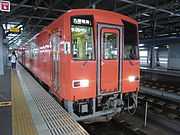KiHa 120
| KiHa 120 | |
|---|---|
 Okayama-based KiHa 120-300 on the Inbi Line, April 2009 | |
| In service | March 1992–Present |
| Manufacturer | JR West (Gotō Works), Niigata Tekkō |
| Constructed | 1991–1996 |
| Number built | 89 vehicles |
| Number in service | 89 vehicles |
| Formation | Single car unit |
| Operator | JR West |
| Depot(s) | Fukui, Hamada, Hiroshima, Kameyama, Kisuki, Okayama, Shimonoseki, Toyama |
| Specifications | |
| Car body construction |
Steel (KiHa 120-200) Stainless steel (KiHa 120-0/300) |
| Car length | 16,300 mm (53 ft 6 in) |
| Width |
2,998 mm (9 ft 10.0 in) (KiHa 120-200) 3,188 mm (10 ft 5.5 in) (KiHa 120-0/300) |
| Doors | 2 folding doors per side |
| Maximum speed | 95 km/h (60 mph) |
| Weight |
26.9 t (KiHa 120-0) 25.9 t (KiHa 120-200) 27.7 t (KiHa 120-300) |
| Engine(s) | SA6D125H-1 |
| Power output |
250 hp (at 2,000 rpm) (KiHa 120-200) 330 hp (at 2,000 rpm) (KiHa 120-0/300) |
| Transmission | Hydraulic |
| Bogies | WDT53 (driving), WT237 (trailing) |
| Braking system(s) | Engine brake, Air brake |
| Safety system(s) | ATS-SW |
| Track gauge | 1,067 mm (3 ft 6 in) |
The KiHa 120 (キハ120形) is a single-car diesel multiple unit (DMU) train type operated by West Japan Railway Company (JR West) on its rural lines in Japan. Based on Niigata Tekkō's "NDC" lightweight diesel car design intended for third sector operators (such as Matsuura Railway, Takachiho Railway, and Kumagawa Railway), a total of 89 cars were built, with the class divided into three sub-classes: KiHa 120-0, KiHa 120-200, and KiHa 120-300.[1]
Variants
KiHa 120-200
Eight first-batch cars were built in 1992. These had painted steel bodies, two-pane windows, transverse and longitudinal seating, and no toilets. All cars were later modified with the addition of toilets.[1]
-

Interior view of KiHa 120-208, March 2007
KiHa 120-0
22 second-batch cars were built in 1993, including three cars built at JR West's Gotō Works. These had uprated engines, stainless steel bodies, single-pane windows, longitudinal seating, and no toilets. All cars were later modified with the addition of toilets.[1][2]
KiHa 120-300
59 third-batch cars were built between 1994 and 1996, including 19 cars built at JR West's Gotō Works. These were similar in design to the KiHa 120-0 subclass, but were built with some transverse seating. Although not initially built with toilets, all cars were modified with the addition of toilets from 2005.[1][2]
Livery variations
-
Fukui-based KiHa 120-205 in original livery, April 2008
-
Fukui-based KiHa 120-201 in revised livery, August 2011
-

Hamada-based KiHa 120-321, September 2008
-

Hiroshima-based KiHa 120-324, November 2008
-

Kameyama-based KiHa 120-303, March 2006
-

Kisuki-based KiHa 120-206, September 2007
-
Kisuki-based KiHa 120-5
-

Okayama-based KiHa 120-334, July 2006
-

Shimonoseki-based KiHa 120-332, September 2007
-

Toyama-based KiHa 120-300s, August 2009
References
| Wikimedia Commons has media related to JR West Kiha 120. |
- ↑ 1.0 1.1 1.2 1.3 JR全車輌ハンドブック2009 [JR Rolling Stock Handbook 2009]. Japan: Neko Publishing. 2009. ISBN 978-4-7770-0836-0.
- ↑ 2.0 2.1 Nishiwaki, Kōji (November 2010). "JR各社の新世代気動車の現状 JR西日本キハ120形" [The Current Situation of JR Group Modern DMUs: JR West KiHa 120]. Japan Railfan Magazine (Japan: Kōyūsha) 50 (595): p.100–105.


